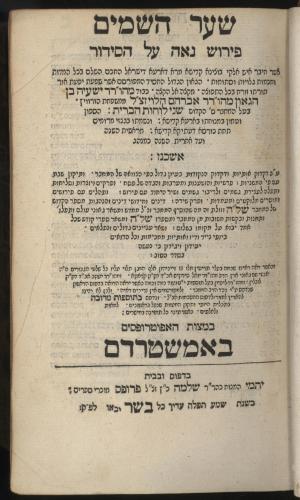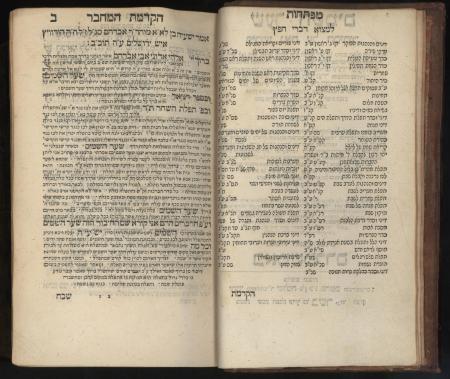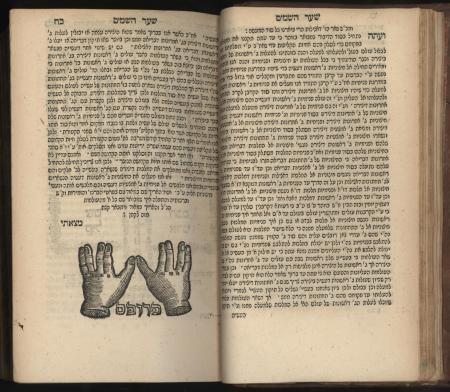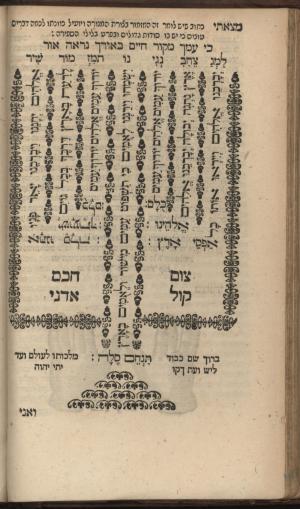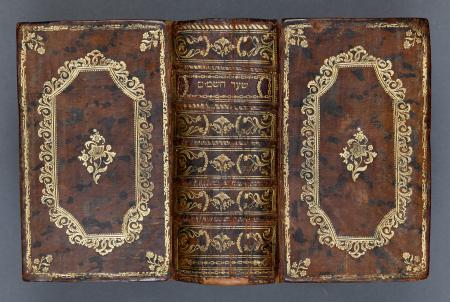Obj. ID: 35482
Jewish printed books Sha'ar ha-Shamaim, Amsterdam, 1742

This text was prepared by William Gross:
Sha'ar HaShamayim – All-year siddur according to Polish custom. With commentaries, laws and manner of conduct, by Rabbi Yeshaya HaLevi Horowitz, author of the Shla. Amsterdam, [1742]. Second edition.
Explanation of the prayers by the author of the Shla, primarily according to Kabbalah (according to various books especially the Arizal's writings which were before him in a manuscript), with a compilation of laws and manner of conduct compiled by his grandson, who published “Shnei Luchot HaBrit”.
The Holy Shla wrote his siddur with the intention of printing and distributing it to the public as he wrote in his testament to his sons: "I thought to compose this holy work to have it printed and spread throughout the Jewish Diaspora, that I shall have a merit and portion in Jewish prayers". Praying from this siddur has a special segula that the prayer shall be accepted and not return unanswered. As the author of the Bach wrote in his approbation to this siddur: "We have no doubt that when it spreads throughout the Jewish world, anyone who prays from it (this siddur), his prayer will not return unanswered". Rabbi Avraham Ya'akov the first Sadigura Rebbe mentioned this segula in his approbation to the third edition of the siddur (Warsaw 1882): "The siddur Sha'ar HaShamayim by the Holy Shla as verified by the author of the Bach in his golden language – we have no doubt that anyone who prays from it, his prayer will not return unanswered". Rabbi Naftali Katz author of “Semichat Chachamim” attributes this segula to the author himself, the Holy Shla, and this is what he writes in his letter: "…the order of the prayers, for each day, for Shabbat, Rosh Chodesh and Yamim Nora'im from the beginning of the year to the end of the year arranged and composed by Rabbi Yeshaya Segal, author of Shnei Luchot HaBrit. He was very attached to this siddur and commanded his descendants to have it printed to give the public the privilege to pray according to this order with these intentions. He made a covenant that if they pray according to this arrangement before He Who Hears Prayers with all their strength and with these intentions, the prayers will not return unanswered. And see the words and approbation of the early great Torah leaders of that time… Rabbi Yoel Sirkis author of Bayit Chadash and Rabbi Ya'akov Av Beit Din of Lublin… and Rabbi Yom Tov Lipman Heller author of the Tosfot Yom Tov… and "all the prophets speak in the same manner" - all the aforementioned Torah scholars, that if a person prays with these intentions his prayers will not return unanswered".
Concurrently, an edition with piyutim "according to Ashkenazi custom" was printed, identical to this edition until leaf 364 (except the title page). From 365 until the end, (Booklet 92), the word "Polish" is printed on the margin of the first leaf of each booklet (on the parallel edition “Ashkenaz” is printed).
This example is bound with two other Amsterdam prints, nos. W1536 and W1554. On the reverse of page 28 is a menorah with Psalm 67.
28, 568 leaves.
The press set up by Solomon Proops became the most famous of all the presses operating in Amsterdam in the 18th century, apart from the Menasseh ben Israel press. Solomon's father Joseph came to Amsterdam from Poznan. Solomon Proops was initially involved in the bookselling trade, and in 1677 was admitted to the Amsterdam Guild of Booksellers, Printers and Bookbinders. In 1704 he set up his own press, which was to become the longest operating and most productive of all the Jewish presses in Europe in the 18th C. He acquired the fame of a printer who produced beautiful books that could be bought at a reasonable price.
Solomon Proops died in 1734, and his three sons Joseph, Jacob and Abraham inherited his press. They were too young to run the press themselves, however, taking over operations only when they reached maturity. Initially Solomon’s sons refrained from listing their names in the works they printed. Instead they identified themselves as “Orphans of the late Solomon Proops”. They only started to place their names on title pages of their works in 1751.
Shaar HaShamayim - German rite, year-round siddur with commentaries, laws and customs, by R. Yeshaya HaLevi Horowitz, author of the Shelah. Amsterdam, [1742]. Second edition. Handwritten Kabbalistic glosses from the 19th/20th century, on pp. 68a; 68b; 224b; 254a; and more (glosses slightly trimmed). Explanation of the prayers by the Shelah, mostly according to Kabbalah (based on various books, especially the Arizal's writings which he had in manuscript), with an anthology of laws and customs which the publisher, his grandson, compiled from Shnei Luchot HaBrit. The Shelah wrote his siddur with the intention of printing and distributing it, as he wrote in his will to his sons: "I thought to compose this holy work, in order that it be printed and distributed throughout the Jewish world, so that I may have a merit and share in all the prayers of the Jewish people". Praying from this siddur bears the special Segulah of the prayer being accepted and not going unanswered. As the Bach wrote in his approbation to the siddur (in the first edition): "We have no doubt that when it becomes widespread amongst the Jewish people, whoever prays from it will not have his prayer rejected". R. Avraham Yaakov, first Rebbe of Sadigura, mentions this Segulah in his approbation to the third edition of the siddur (Warsaw, 1882): "Siddur Shaar HaShamayim by the holy Shelah, as the renowned Torah scholar, the holy Bach, testified… there is no doubt that whoever prays from it, his prayer will not be rejected". The holy kabbalist R. Naftali Katz, author of Semichat Chachamim, ascribes this Segulah to the author himself, the Shelah, as he writes: "…order of prayers… from the beginning of the year until the end of the year, arranged and composed by R. Yeshaya Segal author of Shnei Luchot HaBrit, and he was very attached to this siddur, and directed his descendants to publish it, to give the public the privilege of praying in this order, with these Kavanot, and pledged that whoever prays with all his might in this order with these Kavanot, his prayers will not go unanswered. Go out and see how people practice, and the approbations of the great Torah scholars of that generation… R. Yoel Sirkis author of Bayit Chadash, and R. Yaakov Rabbi of Lublin… R. Yom Tov Lipman Heller author of Tosfot Yom Tov… and they all concur that whoever prays with these Kavanot, his prayer will not be rejected". 28, 528 leaves. 15.5 cm. Good-fair condition. Stains, minor tears and wear. Minor tears and damage to approx. ten leaves, repaired with acidic tape, affecting text (title page; leaves 76-80, 113, 134-136, and more). New binding. From leaf 365 onwards (gathering 92), the word "Ashkenaz" is printed at the foot of the first leaf of each gathering. Another edition was printed concurrently, identical until leaf 364 (apart from the title page), with Polish-rite piyyutim. In that edition, from leaf 365 onwards, the word "Polish" was printed at the beginning of each gathering.
Commentator: Yeshaya ben Avraham Halevi Horowitz


